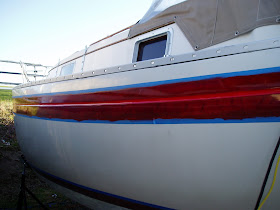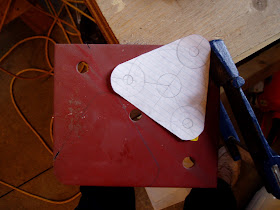This is the new and improved version of my first cup holder. I tried to add the mount for the chart plotter, and was successful, but I was not happy with the strength, and decided it should be one piece, so I built this one. The back is all one piece, including the triangle piece in the photo, which is the mount, and the top portion fits around it. Here it is with the first coat of Cetol.
The interior of the fridge box finally got all glassed in. I sanded it down yesterday, taking all the bumps off, and then thickened up some epoxy to smooth it out even further. A couple of applications like that and then a final sand, and it will be ready for gel-kote. Its kind of like finishing drywall, except this stuff is toxic, and doesn't sand quite as easy.
Next came the anchor windlass. This setup has cost me a lot of lost sleep. Trying to figure out the best way to mount this. I finally decided to cut the door in half, permanently mount the front half of the door, and hinge the back part of the door off of the front half. This does a few things, it keeps the anchor windlass as close to the bow as possible so that the chain is not running across the deck grinding down the gel-kote, keeps the foredeck relatively clear, maintains use of the the deck locker for bow lines, and snubbers, etc... Makes sure that the door does not open when green water comes over the deck. And, allows room for the dinghy to fit between the mast and the windlass, for those times when it is just better to have it mounted on deck.
I toyed with mounting the windlass in front of the door, with mounting it behind the door, with getting rid of the door, or mounting the windlass inside the locker. All things considered, to my feeble mind, this was the best of all worlds.Then I took an idea from the Guru of small boat Guru's, James Baldwin, and mounted the windlass and the two deck pipes up on blocks. I probably should have made them out of teak, but I don't have any, and at $32.00 per board foot plus tax (price confirmed), I'm not likely to ever have any. However, for weather, cedar works just as well, is strong, is light, and is in my shop. I made the base for the windlass out of 2" stock and the base for the deck pipes from 1" stock. And the reason is because I can't get the deck pipes close enough to the windlass to allow the chain to properly fall straight in and still be able to remove the cap from the deck pipe without having the windlass that extra inch higher. And if I remember, James's reasoning was to limit the amount of deck water that found its way below, so it works for that too.
I routed out the bottom of the 2" block so that the deck pipes could be inset, and as close as possible to the windlass. This also helps keep them in between the edges of the hatch, because there isn't a whole lot of room to work with there.
And here they are with the first coat of Cetol. I figured I might as well finish them up in the shop and then install them. I have time, as the door needs to be bulked up, and glassed into the deck prior to installation.
Today is cold as hell. So no epoxy or paint. I think I'll try and get the bowsprit sanded down, tape off the boot strip so I can finish that, put the stuffing box back together, and what ever else takes my fancy. It is so hard to get things done when it is this cold out. Right now the weather man says we have a -5 deg C windchill. Brrrrr... I'll play around in the shop as long as I can get away with it. Tomorrow is first lift in, so will be a busy day, Sunday and Monday should be good work days, and Tues is supposed to rain again. Its okay though, Tues is shopping day, I have a big order waiting at Pride Marine, and my davits are ready. Can't wait to get them on, then I can get the name and port of call installed.
Until later.
Rob.
























































